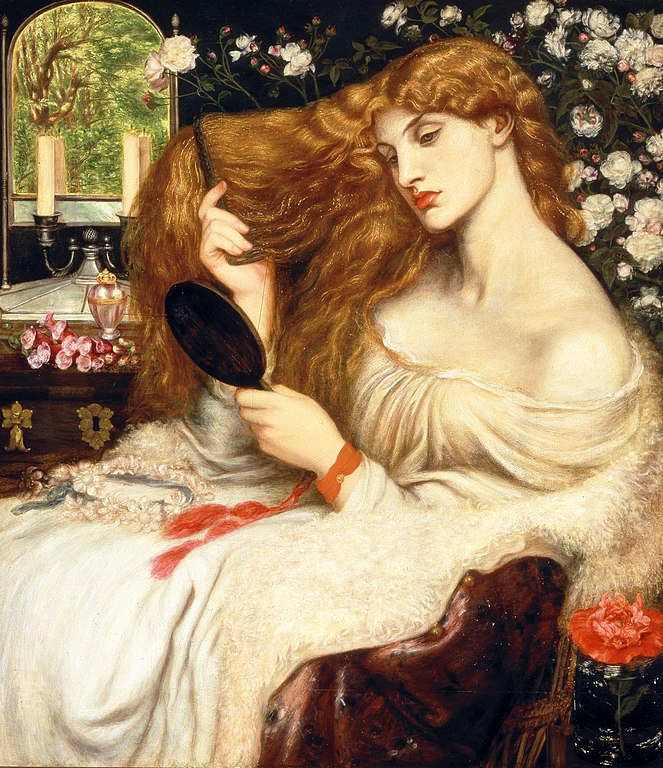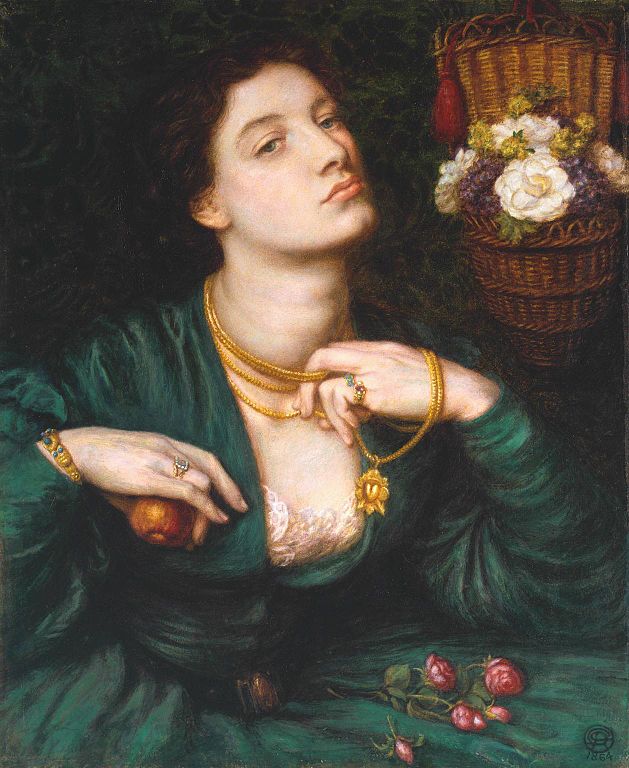A Lock of Hair, a Bite of Fruit: Sexual Economics in Goblin Market
The story of Laura and Lizzie begins with a lock of hair. A pair of sisters in Christina Rossetti’s 1862 poem Goblin Market[1], the two girls presumably live alone on a homestead and are depicted as near-identical and of indeterminate age. “Golden head by golden head” is how they rest together, “Like two wands of ivory / Tipp’d with gold for awful kings” (189-190). This twindom, however, is dependent on their health. When Laura snips a curl from the “gold upon her head” (123) in exchange for the fruits sold by the eponymous goblins, we see this doubling cease. Her hair grays, her eyes sink, the color fades from her mouth, and Lizzie is left to tend to the domestic and agricultural tasks alone. The fruit itself is bought with a snip from the very body upon which it wreaks havoc. Many readings of Goblin Market focus on Laura as a guilty victim of her own willingness to be seduced, but Laura’s actions may also represent self-assertion of her own embodiment. However, when operating symbolically in a male-generated signifying system, her assertive acts are expropriated in the interest of male power and control. This expropriation and the tension it causes mimics the treatment of female embodiment in the Victorian imagination at large, in which feminine symbols are forced into instability and cause chaos for those ensnared—particularly women.

Dante Gabriel Rossetti, Lady Lilith (1866-68, altered 1872-73). Oil on canvas, 38.5×33.5″. Image via Wikimedia Commons.
*
There is no rest for the ears of maidens in Goblin Market. “Morning and evening,” they hear goblins beckoning: “Come buy our orchard fruits / Come buy, come buy” (1-4). Though explicitly referred to as “men” (42), or “brothers” (92), Rossetti defines them according to the creatures they resemble. Lines 71-76 describe a “cat’s face,” a whisking “tail,” a movement of a “rat’s pace,” a “snail’s crawl.” Many of the resembled animals hail from disparate lands: the wombat is from Australia, while the ratel is commonly found in Southeast Asia and parts of Africa. The men themselves seem to travel locally, but their animal qualities do not naturally coexist outside the realm of the text. Alongside her choice to omit any reference to Laura and Lizzie’s age, this detail allows Rossetti to immediately destabilize any assumption of the spatial and temporal location of Goblin Market. The goblins’ status as men, however, allots them a certain familiarity, allowing the text to refuse commitment to reality or the supernatural. It is often noted by critics that the goblins’ bounty of fruits, whose names occupy forty-six (5-29, 170-179, 289, 352-362) of the poem’s lines and range from apples to dates to “bright fire-like barberries,” are all impossibly ripe at the same time. Like the men, the bounty simultaneously offers something safe to approach yet magically unique, never-before-seen in such combination and excess but sure to provide nourishment. Early in the poem, Laura warns that she and Lizzie must not eat of these fruits, for “‘Who knows upon what soil they fed / Their hungry, hungry roots?’” (44-45). This notion of foreignness, of unpredictable origin, is emphasized by the question mark, and an assumption of some exotic, exceptional vitality in what the goblins sell is established by the twice-repeated “hungry.” But this element of the poem is not always emphasized by Rossetti—her lines’ repetitive yet irregular structures even allow for one to overlook it. As a result of her refusal to commit to a single reality for the text to inhabit, Rossetti refuses commitment to one symbolic meaning for the goblins and the fruits.
In the signifying system of Victorian cultural symbols, even a woman’s hair could be expropriated in the interest of male control, as a force of erotic manipulation and phallic threat as well as of angelic beauty and comfort. This phenomenon can be seen in Browning’s “Porphyria’s Lover,” various paintings by The Pre-Raphaelite Brotherhood, the tale of Elizabeth Siddal’s exhumation, and countless other works. Rossetti’s ambivalent treatment of her poem’s goblins and fruits codes them as both familiar and threatening, sometimes at once, mimicking the unstable Victorian signification system. Wrestling as they do in the chaotic realm of symbols, what is one to make of Rossetti’s fruits, specifically? It need not be harped on that fruit itself is coded as feminine, operating not only as a reminder of feminine guilt and sin in biblical symbology but also as a sensual object which rhymes visually with female genitalia and functionally (by way of both fertility and nourishment) with female reproductive organs and breasts. These varying functions of fruit tend to entangle, particularly when the fruit comes into contact with a female figure—namely, a virgin.
Christina Rossetti’s brother, Dante Gabriel Rossetti, was a founding member of the Pre-Raphaelite Brotherhood and a prominent artist and poet. In one of his eight versions of the painting Proserpine, the figure walks a fine line between succumbing to and possessing the pomegranate she grasps. The sitter is Dante Gabriel’s wife, Elizabeth Siddal, and is depicted with a wealth of hair cascading serpentine, dark as night and equally impenetrable. Her garment drapes with an emerald not unlike that of a scaled beast, but the most serpentine movement is in the figure’s neck. Muscles rise, nearly hunch from the shoulders, giving way to a curve in the neck that resembles the strong twist of an anacondian body mid-constriction. It is visually brief, but inspires fixation. The pomegranate she holds may represent the sin of erotic enticement itself, but it can’t be ignored that fruit and flower have been consistent symbols for the female body itself, rather than for only the erotic sensation that compels the mouth to bite. She holds, then, her own form, unable to be divorced from sex as a concept, while aspects of that form both mimic and taunt a male body. As with hair, the feminine association with fruit refuses symbolic clarity and cleanliness. The multiplicity of meaning made available by women according to the Victorian imagination is not unlike the multiplicity that one finds in Goblin Market—contradictory, frustrating, fascinating, and seemingly indispensable.
Viewed in this light, the goblins are in the business of offering this entanglement of symbols to the chaste young women who can hear their calls. These women are tasked not only with resisting the symbol of sex as an act but also of their own male-made identity, the actual fruits of that culture-saturating thought. As Terrence Holt writes, the poem’s language “cannot escape from gender,” which “undoes the attempt: the autonomy is an illusion.”[2] Even as no non-goblin man, nor any other human at that, is visible onstage in Laura and Lizzie’s world to enforce restrictive cultural values, the results of Laura’s supposed attempt at autonomy are near-fatal. Despite her physical and mental deterioration, she continues to crave the fruits of the goblins, yet she can no longer hear their chants. Has she been cast out from the sexual marketplace?
There is no suggestion of any rabid craving for the fruits or the man-creatures on Laura’s part earlier on in the poem. She begins as a curious listener: she “bow’d her head to hear” (34). It is initially Laura coolly insisting to both Lizzie and herself:
“Lie close,” Laura said, Pricking up her golden head:
“We must not look at goblin men, We must not buy their fruits:
Who knows upon what soil they fed Their hungry thirsty roots?” (40-46)
To echo my previous examination of the fruit as a symbol that treats sex as a (sinful) act irreparably entangled with the female body, Laura might be seen as trading her lock of golden hair, monetarily and socially precious for its color, in order to gain access to her own body as a sexual being. The one tear, which critics such as Holt see as borne of guilt, might instead be borne of brief, understandable mourning for a time of innocence now lost, as well as a piece of the body now given away. The losses have occurred by choice. Viewed in this light, Laura’s act of gifting hair (a Victorian social norm) can be seen as intimate, if only in an abstract exchange with her own self and feminine form, the goblins acting as middle-men, vehicles. After all, it is not until she realizes the social consequences of her choice—”Laura turn’d cold as stone / To find her sister heard that cry alone” (253-254)—that the negative effects of that choice take hold on her body and spirit. The act of a snipping a golden lock is here reframed as a possibly self-inflicted defilement. Due to the physical manifestations of her suffering that occur after this realization, her decision is no longer private, and the question of whether it ever was is a cause of great suffering for both the poem and its readers.

Dante Gabriel Rossetti, Venus Verticordia (1864-1868). Oil on canvas, 32 x 26.7″. Image via Wikimedia Commons.
Laura’s predecessor in the marketplace exchange, the unfortunate Jeanie, is referred to as being in her “gay prime” (316) when she dies as a result of her indulgence in the goblins’ offerings. While Rossetti maintains the joyful tone of the word “gay,” it had also been used (since 1825) to refer to prostitutes (women), and womanizers (men).[3] But the goblin/girl dynamic of the poem is equally if not more analogous to a reversed prostitution scenario, rather than a typical one of male pimp/female prostitute. Even as the text gestures towards the latter reading, one does not find in Goblin Market a woman receiving money in exchange for pleasing a self-sufficient man. While the aforementioned act of exchanging the synecdochal body-as-lock-of-hair for a symbolically sexual good may be thought of as representational prostitution, this particular exchange is not a condition of the market. The goblins do accept coins, but are willing to barter, seemingly manipulatively. What one does find in the poem is a highly independent girl, alone in life with a sister, a farm of some size, a domestic and agricultural livelihood to maintain. By daylight, the pair labor intensely. They rise with the dawn to milk cows, fetch honey, sew, churn butter, tend to their hens, and, perhaps most interestingly, bake many cakes from wheat they’ve grown, perhaps for participation in a market of their own. The virgin purchases the disembodied image of her own sexuality from the men, navigating the desire of what is hers physically but not symbolically, and consuming the symbol with the very body it references.
This “reversal” of the sexual marketplace in Goblin Market is by no means absolute, or perhaps even cleanly a reversal. But the poem is certainly offering a morphed image of prostitution in Victorian England, and it makes that image available by leaning on the fantastical. Laura’s somewhat level-headed approach of the goblins says much about the ways in which one can interpret Lizzie as the text’s complex heroine. In order to cure her sister’s addiction, Lizzie pays the goblin men and holds out her apron to be filled with fruits. Instead, the men offer her a seat at their meal, and grow angry when she refuses to join them. She resists their assaulting attempts to force the fruits into her mouth “Like a lily in a brook … Like a royal virgin town” (409-418) until she is covered in juices. Returning home, she urges a wasting Laura to “Hug me, kiss me, suck my juices … Eat me, drink me, love me; Laura make much of me” (468-472). Like the girls before her, Lizzie re-appropriates the structure of erotic symbols which defines, entices, and controls her own embodiment as a sexual being. Laura swiftly regains her health and youth as a result.

Dante Gabriel Rossetti, Monna Pomona (1864). Oil on canvas, 18.7 x 39.3″. Image via Wikimedia Commons.
Lizzie’s “resistance” to the goblins is hardly depicted as characteristic of that term. She displays no true struggle. As a savior figure, Lizzie also intrigues the reader through the poem’s focus on her twin-like identity with Laura, which seems in a complementary position to the goblins as “brothers” that linguistically morph into “one” as expressed in lines 90-96. Among the many accomplishments of this Gothic-double function, it allows each character an emphasis on her individual identity when the mirror images fail to align, contributing to a performance of both the assertion of individual agency and the ability for such agency to be depleted entirely by the world that governs it. The union of Laura and Lizzie that follows their physical event nearly mimics an idealistic marital union in its replenishment of each girl’s wellness and sense of self. Does it banish the goblins? One result of Lizzie’s redemptive act is a seeming eradication of men from the pair’s immediate vicinity, which drifts on the margin of reality and fantasy. Lizzie’s act has been referred to numerous times as Christ-like, but it seems wrong to ignore that Laura’s plight mimics contemporaneous fears of venereal disease and other sexually transmitted infections. Victorians, after all, believed in the “virgin cure” for these ailments, as a concerning percentage of people still do today, and Lizzie fits the bill.
In the atemporal space that Rossetti allows her characters to inhabit, the endless reliance on symbols appears not dissimilar to the paintings of the Pre-Raphaelite Brotherhood. Each is heated, indulgent, richly colored, languid, bewildering. Despite the apparent irresolvablility of Goblin Market, it is its ability to function as a many-sided social, political, and personal critique (extending well beyond its phantasma) that sets it apart from the paintings of Rossetti’s male contemporaries. Her ambivalent reliance on symbols as secure one-to-one linkages, as well as modes for generating meanings that extend beyond such simplicity, does maintain the risk of ensnarement for the subjects at hand. But, by allowing female bodies to re-appropriate the threat of a male-generated signifying system, Rossetti is able to expose that ensnarement while working to upend it.
[1] Christina Rossetti, Goblin Market and other Poems (Cambridge: Macmillan, 1862; Toronto: University of Toronto Press, 1997), references are to line numbers as in the original text and online version, http://faculty.smu.edu/nschwart/2311/goblin_market.htm
[2] Terrence Holt, “‘Men Sell Not Such in Any Town’: Exchange in Goblin Market,” Victorian Poetry 28, no. 1 (1990), 51.
[3] Douglas Harper, ed. “Gay” in Online Etymology dictionary, https://www.etymonline.com/word/gay




Dilettante Mail
Get updates from us a few times a year.